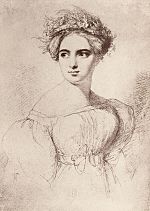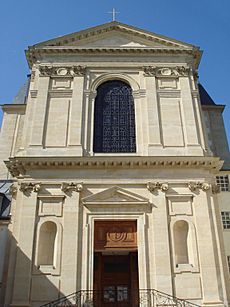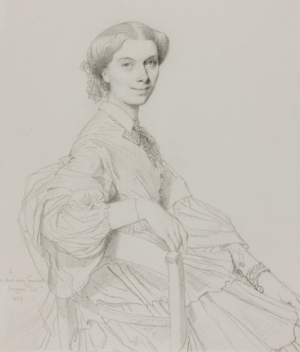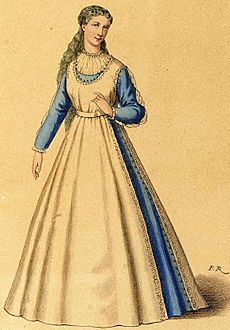Charles Gounod facts for kids
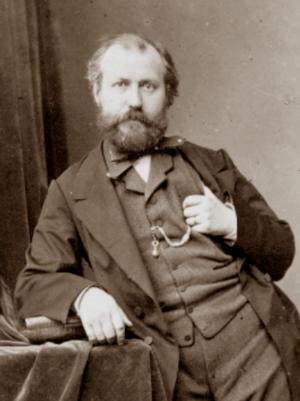
Charles Gounod (born June 17, 1818 – died October 18, 1893) was a famous French composer. He wrote many different kinds of music, including twelve operas. His most popular opera is Faust (from 1859). Another one, Roméo et Juliette (from 1867), is also still performed around the world.
Gounod also wrote a lot of church music, many songs, and popular short pieces. These include his well-known Ave Maria, which uses music by Bach. He also wrote the fun and spooky "Funeral March of a Marionette".
Charles Gounod was born in Paris into a family of artists and musicians. He studied at the Conservatoire de Paris, a famous music school. He won France's top music award, the Prix de Rome. This prize allowed him to study in Italy, Austria, and Germany. In Germany, he met the composer Felix Mendelssohn, who introduced him to Bach's music.
Gounod was a very religious person. After returning to Paris, he even thought about becoming a priest for a short time. He wrote a lot of music, including church music, songs, orchestral pieces, and operas.
Gounod's career was interrupted by the Franco-Prussian War in 1870. He moved to England with his family to escape the war. After the war ended in 1871, his family went back to Paris. However, Gounod stayed in London for a while. He lived with a family who helped him with his music. After almost three years, he returned to his family in France.
Because he had been away, and because new, younger French composers were becoming popular, Gounod was no longer the most famous French musician. Even though people still respected him, some thought his music was old-fashioned. He did not have as much success with new operas later in his life. He passed away at his home near Paris when he was 75 years old.
Today, only a few of Gounod's works are regularly performed. But he had a big impact on later French composers. His music had a romantic, emotional side that influenced composers like Jules Massenet. It also had a calm and elegant side that influenced Gabriel Fauré. Another famous composer, Claude Debussy, said that Gounod truly showed the French spirit of his time.
Contents
Life and Career
Early Years and Education
Charles Gounod was born on June 17, 1818, in a part of Paris called the Latin Quarter. His father, François Louis Gounod, was a painter and art teacher. His mother, Victoire, was a talented piano teacher. Charles's older brother, Louis Urbain, became a successful architect. When Charles was very young, his family lived in an apartment at the Palace of Versailles. This was because his father worked for a member of the royal family.
After his father died in 1823, Charles's mother supported the family by teaching piano again. Charles went to several schools in Paris, including the Lycée Saint-Louis. He was a good student and was very good at Latin and Greek. His mother wanted him to become a lawyer, but Charles loved the arts. He was a talented painter and an amazing musician.
Early in his life, he was influenced by his mother's music lessons. He also loved going to the opera. He saw operas like Rossini's Otello and Mozart's Don Giovanni. He later said that watching Don Giovanni in 1835 made him feel "one long rapture." Later that year, he heard Beethoven's Pastoral and Choral symphonies. These added "fresh impulse to my musical ardour."
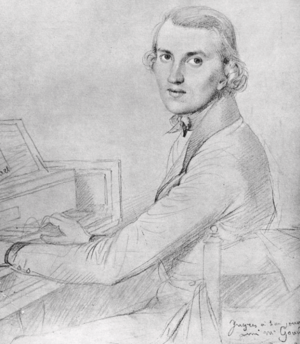
While still in school, Gounod studied music with Anton Reicha, who was a friend of Beethoven. In 1836, Gounod was accepted into the Conservatoire de Paris. There, he studied how to compose music and play the piano. His teachers did not influence him much. But he met Hector Berlioz, another famous composer. Gounod later said that Berlioz and his music were very important to him when he was young. In 1838, Gounod composed a part of a special church service (a Mass) for a teacher who had passed away. Berlioz said Gounod's part was "beautiful – very beautiful." He added that "we may expect everything of him."
Winning the Prix de Rome
In 1839, after trying three times, Gounod won France's most important music prize, the Prix de Rome. He won it for his cantata called Fernand. This prize was a big step for his music career. It also made a lasting impression on his spiritual and musical life. The prize allowed him to study for two years in Rome, Italy. Then he spent another year in Austria and Germany.
The director of the French Institute in Rome was the painter Jean-Auguste-Dominique Ingres. He had known Gounod's father well and helped Charles.
In Rome, Gounod met important artists like the singer Pauline Viardot and the pianist Fanny Hensel. Fanny was the sister of Felix Mendelssohn. Viardot later helped Gounod a lot in his career. Through Fanny, Gounod learned about the music of J. S. Bach. Mendelssohn was helping to bring Bach's music back into popularity. Gounod also heard "various masterpieces of German music which I had never heard before."
While in Italy, Gounod read Goethe's Faust. This inspired him to start writing music for an opera based on the story. This opera would become his most famous work many years later. He also composed some of his best-known songs during this time. These include "Où voulez-vous aller?" (1839) and "Venise" (1842). He also wrote a Mass, which was performed in a church in Rome.
In Rome, Gounod's religious feelings grew stronger. He was inspired by a preacher and by the beautiful paintings in the city's churches. He also learned about and admired the sacred music of Palestrina. He called it a musical version of Michelangelo's art.
For the last year of his prize, Gounod moved to Austria and Germany. In Vienna, he heard Mozart's The Magic Flute for the first time. He loved being in the city where Mozart and Beethoven had lived. His Requiem Mass was performed in Vienna and was well-received.
From Vienna, Gounod went to Prussia. He met Fanny Hensel again in Berlin. Then he went to Leipzig to meet her brother, Felix Mendelssohn. Mendelssohn was very encouraging. He even arranged a special concert so Gounod could hear his "Scottish" Symphony. Mendelssohn also played Bach's works on the organ for Gounod. Gounod played a part of his Requiem for Mendelssohn. Mendelssohn praised it, saying it was good enough to be signed by another famous composer, Luigi Cherubini. Gounod said, "Words like this from such a master are a true honour."
Growing Reputation
Gounod returned to Paris in May 1843. He became the chapel master at the church of the Missions étrangères. This was not a very important job for someone who had won the Prix de Rome. The church's organ was not good, and the choir was very small. Also, the church members did not like his attempts to improve the music.
Despite these problems, Gounod kept working hard. He slowly won over the church members and stayed for most of his five-year term. During this time, Gounod's religious feelings became very strong. He even thought about becoming a priest. In 1847, he began studying religion. But soon, he decided to continue his career as a musician instead.
Gounod's career in opera got a big boost when he met Pauline Viardot again in Paris in 1849. Viardot was a very famous singer. She helped him get a chance to write a full-length opera. This was very lucky for a new composer. Usually, they would only be asked to write a short piece.
Gounod and his writer, Emile Augier, created Sapho. It was based on an old Greek legend. This opera was different from the types of operas popular in Paris at the time. It was later seen as the first of a new type called opéra lyrique. Sapho was performed at the Paris Opéra on April 16, 1851. A critic, Berlioz, found some parts "extremely beautiful" and others "hideous." The public did not like it much, and it closed after only nine performances.
In April 1851, Gounod married Anna Zimmerman. She was the daughter of his former piano teacher. Gounod was also put in charge of singing instruction for Paris schools. From 1852 to 1860, he directed a well-known choir group. He also often filled in for his father-in-law, teaching music to students. One of his students, Georges Bizet, found Gounod's teaching very inspiring. He remained a fan of Gounod throughout his life.
Even though Sapho was not a big hit, it helped Gounod's reputation. He was asked to write music for a play called Ulysse (1852), based on the Odyssey. This play was not very successful, and the audience was not interested in the music.
During the 1850s, Gounod composed two symphonies for a full orchestra. He also wrote one of his most famous religious works, the Messe solennelle en l'honneur de Sainte-Cécile. This Mass was written for a celebration in 1855. It showed how well Gounod could mix opera style with church music.
Gounod also continued to write operas. His next one was La Nonne sanglante (The Bloody Nun, 1854). This was a dramatic ghost story. Critics did not like the story, but they praised the music. The opera was doing well until it was stopped by a new director who disliked it.
Operatic Successes and Challenges
In January 1856, Gounod was made a knight of the Legion of Honour. In June of that year, he and his wife had their first child, a son named Jean. Their daughter Jeanne was born seven years later.
In 1858, Gounod composed his next opera, Le Médecin malgré lui. It was based on a comedy by Molière. Critics loved it, but Gounod was sad because his mother died the day after the first performance. An opera was considered a success if it ran for 100 performances. Le Médecin malgré lui reached that goal and was performed many times in Paris and other cities.
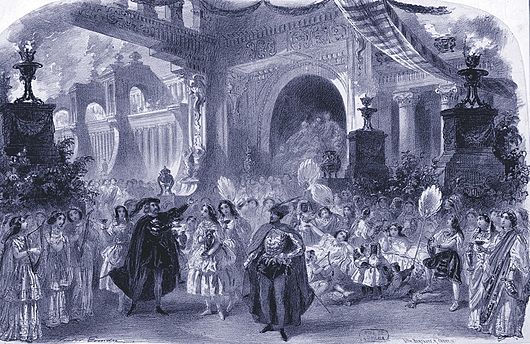
With his writers, Gounod then turned from French comedy to a German legend for Faust. They had started working on it in 1856. The opera opened in March 1859. At first, it "did not strike the public very much," Gounod recalled. But after some changes and strong promotion by his publisher, it became a huge international success. It was performed in Vienna in 1861, and in Berlin, London, and New York in 1863. Faust has remained Gounod's most popular opera and is still performed often today.
Over the next eight years, Gounod composed five more operas. Philémon et Baucis (1860) and La Colombe (The Dove, 1860) were light comedies based on stories.
After these moderate successes, Gounod had a big failure with La Reine de Saba (1862). This was a grand opera with an exotic setting. Even though it was a lavish show, critics did not like it, and it closed after only fifteen performances. Gounod was sad about this failure and took a long trip to Rome with his family. The city still charmed him and gave him new energy for his work.
Gounod's next opera was Mireille (1864). This was a five-act tragedy set in the French countryside. Gounod traveled to the region to get a feel for the local atmosphere. Some people see this opera as an early example of verismo opera, which focuses on realistic stories. The opera was not a huge success at first. But after some changes, it became popular in France.
In 1866, Gounod was elected to the Académie des Beaux-Arts, an important arts academy. During the 1860s, he also wrote other works. These included a Mass (1862), a Stabat Mater (1867), and many other religious pieces. He also wrote a Marche pontificale for the Pope, which later became the official anthem of the Vatican City.
Gounod's last opera of the 1860s was Roméo et Juliette (1867). The story follows Shakespeare's play quite closely. This opera was a success from the very beginning. It was performed in major opera houses in Europe, Britain, and the US within a year. Besides Faust, it is the only Gounod opera still often performed internationally.
Time in London
When the Franco-Prussian War started in 1870, Gounod and his family moved from their home near Paris to England. Their home was destroyed by the advancing Prussian army. To make money in London, Gounod wrote music for a British publisher. There was a big demand for religious songs in Britain at that time, and he was happy to write them.
Gounod was asked to write a choral piece for the opening of the Annual International Exhibition in London in 1871. It was very well-received. Because of this, he was made director of a new choral society, which later became the Royal Choral Society. He also conducted orchestral concerts in London. Some people complained that Gounod did not feature enough British composers in his concerts. However, his own music was very popular and praised.
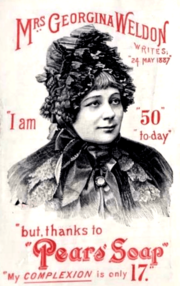
In 1871, Gounod met a singer and music teacher named Georgina Weldon. She became an important person in his life. After peace returned to France in 1871, Gounod's wife and children went back home. But Gounod stayed in London, living in the Weldons' house. She helped him with his business dealings with publishers.
Gounod lived with the Weldons for almost three years. French newspapers wondered why he stayed in London. In 1874, Gounod became very stressed. His friend Gaston de Beaucourt came to London and took him back to Paris. Weldon was very angry that Gounod had left. She caused him many problems later, including keeping his music manuscripts. She also wrote her own story about their time together.
Later Years
The music scene in France had changed a lot while Gounod was away. Before, he was seen as France's top composer. When he returned, he was still respected, but he was no longer at the forefront. A new generation of composers, like Bizet and Jules Massenet, were becoming popular. Gounod was not bitter about this. He was kind to younger composers, even if he did not always enjoy their music. He was most impressed by Camille Saint-Saëns, who was 17 years younger than him. Gounod reportedly called him "the French Beethoven."
Gounod started composing operas again. He finished Polyeucte, which he had been working on in London. In 1876, he composed Cinq-Mars, a historical drama. Cinq-Mars was performed in April 1877, but it only had 56 performances. Polyeucte, which was a religious story important to Gounod, did even worse the next year. It only had 29 performances.
Gounod's last opera, Le Tribut de Zamora (1881), ran for 34 nights. In 1884, he made changes to Sapho, which ran for 30 performances. Even with these disappointments, Faust continued to be very popular. In November 1888, Gounod conducted the 500th performance of Faust at the Opéra.
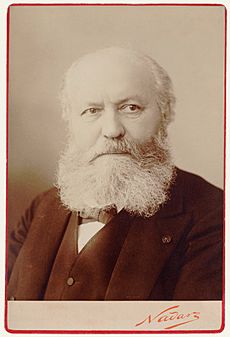
Outside of opera, Gounod wrote a large Mass in 1876 and ten other Masses between then and 1893. His biggest popular successes later in his career were religious works. These were two large oratorios, La Rédemption (1882) and Mors et vita (1885). Both were written for and first performed at a music festival in England. These two works were very popular in Britain and Europe. At the time, they were considered as important as the oratorios by Handel and Mendelssohn.
Gounod spent his last years at Saint-Cloud, composing sacred music and writing his memories and essays. On October 15, 1893, after playing the organ at his local church, he had a stroke. He was working on a Requiem Mass for his grandson, who had died as a baby. After being in a coma for three days, Gounod died on October 18, at age 75.
A state funeral was held for him in Paris on October 27, 1893. Many important people attended. The music was conducted by Gabriel Fauré. As Gounod wished, the music was all singing, with no organ or orchestra. After the service, Gounod was buried in his family's tomb near Saint-Cloud.
Music
Gounod is most famous for his operas, especially Faust. His religious music was very popular during his lifetime, but it is not heard as often today. His songs were important for later French composers, and some are still well known. Music experts say Gounod's music has "considerable melodic charm" and "admirable orchestration." They also say he was best at smaller, more intimate pieces rather than very large ones. Many agree that his best work was from the earlier parts of his career.
Operas
Gounod wrote twelve operas, in different styles popular in France. Sapho (1851) was an early example of opéra lyrique. This style was smaller and more personal than grand opera. It had continuous music, unlike opéra comique which had spoken parts. Critics noted Gounod's "genuine talent for music-drama" in this work. He changed the opera several times, but it was never a big success. One well-known song from it, "O ma lyre immortelle," was a reworked song he wrote in 1841.
La Nonne sanglante (1854) was a larger opera. It was a mix of historical grand opera and a supernatural story. It included parades, ballets, and large group songs. Critics have described its music as "refined, sombre, and labyrinthine."
Le Médecin malgré lui (1858) is considered one of Gounod's best works. It is a three-act comedy, described as "witty, quick-moving and full of life." Famous composers like Richard Strauss and Igor Stravinsky thought it was a masterpiece. It was popular in the late 1800s.
Faust (1859) became popular because of its beautiful tunes and natural feel. Unlike other grand operas of the time, it told its story simply, without huge ballets or over-the-top effects. People found its "charm... in its naturalness, its simplicity, the sincerity and directness of its emotional appeal." Some of the most famous parts include Marguerite's "Jewel" song, the Soldiers' Chorus, and Méphistophélès' "Le Veau d’or." The ballet music, added later for performances at the Opéra, also became very popular.
Philémon et Baucis and La Colombe are light and charming works. La Colombe is "well filled with the kind of ingratiating tunes that Gounod could turn out so effectively." Although La Reine de Saba was a failure, it has a few songs that became somewhat popular.
Mireille (1865) was a moderate success and stayed popular in France. Its most famous song is the waltz-song "O légère hirondelle," which is a favorite for many sopranos. Gounod made changes to the opera, even giving it a happy ending at one point.
Gounod's last successful opera was Roméo et Juliette (1867). It was a hit from the start. While not as popular as Faust, it is still performed internationally. Romeo's "Ah! levè-toi, soleil" is considered one of Gounod's best tenor songs. Gounod did not have more success with new operas after this. His last three, Cinq-Mars (1877), Polyeucte (1878), and Le Tribut de Zamora (1881), were not popular and are rarely seen today.
Orchestral and Chamber Music
Gounod wrote two symphonies, in D major and E-flat major, around 1855-1856. Like many composers of his time, Gounod felt the strong influence of Beethoven when writing symphonies. Gounod's student, Bizet, used Gounod's First Symphony as a model for his own famous Symphony in C. Gounod started a Third Symphony later in life but did not finish it.
Other orchestral works include the "Funeral March of a Marionette" (1879). This piece was originally for solo piano and later arranged for orchestra.
The Petite Symphonie (1885) was written for nine wind instruments. It has four movements, like a classical symphony. It is described as having a "cheerfully contemplative and gallant wit."
Gounod's Ave Maria became very popular. It is a melody Gounod wrote over a famous piece by Bach. It was originally for violin and piano. The words of the Hail Mary prayer were added to the melody later.
Religious Music
Gounod wrote a lot of religious music. This includes 23 Masses, over 40 other Latin church pieces, more than 50 religious songs, and seven cantatas or oratorios. During his lifetime, many people thought his religious music was even better than his operas. However, in the 20th century, opinions changed, and his religious music became less popular.
Experts often say Gounod's early Masses are his best religious music. He moved from a strict, older style to a more flowing, operatic style in his Messe solennelle de Sainte Cécile (1855). Generally, Gounod's work in the 1860s became more like Italian music, but still kept its French qualities of precision and elegance.
Songs
Gounod wrote more songs than any other type of music. He composed over a hundred French songs and thirty more in English or Italian for the British market. His best songs are generally thought to be from his earlier years. The composer Maurice Ravel called Gounod "the true founder of the mélodie in France." This means Gounod helped create the style of French art song.
From his early period, during and after his time as a Prix de Rome student, Gounod wrote some of his best songs. Examples include "Où voulez-vous aller?" (1839) and "Venice" (1842). These songs show Gounod's "melodic genius" and his ability to create long, flowing musical lines.
Songs from Gounod's middle and later years are generally considered less impressive. However, some songs he wrote while in England in the 1870s are still very good. These include "Oh happy home" and "If thou art sleeping, maiden." While in Britain, Gounod also arranged Scottish folk songs and set poems by famous English writers to music.
Legacy
Even though only a small part of Gounod's music is still regularly performed, he had an important influence on later French composers. He expressed a range of emotions in his music that had not been heard before. His influence can be seen in composers like Fauré, who took inspiration from Gounod's elegant style. Massenet, on the other hand, was influenced by Gounod's more romantic and emotional side. Ravel praised Gounod's importance to French song. Debussy wrote that Gounod's art "represents a moment in French sensibility" and "is not forgotten."
Images for kids
See also
 In Spanish: Charles Gounod para niños
In Spanish: Charles Gounod para niños



